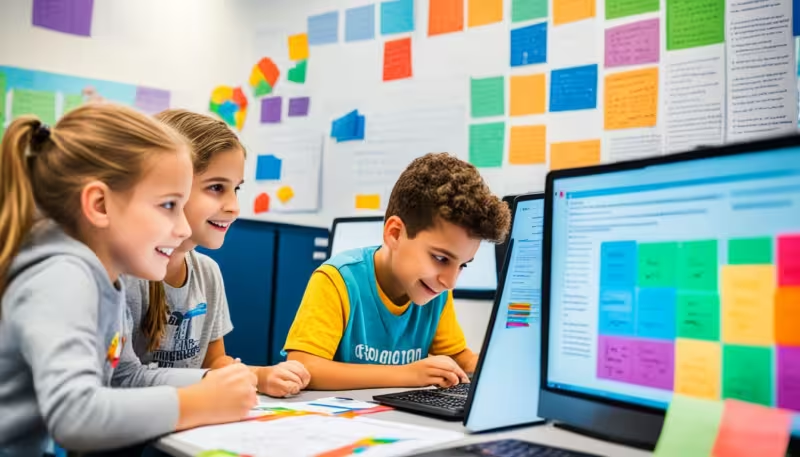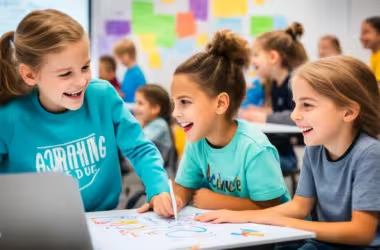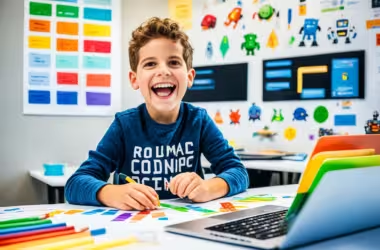Why are more parents looking at coding to boost their kids’ math skills? Coding merges imagination and logical thinking. It brings kids into the world of programming. At the same time, it sharpens math abilities like problem-solving and logical reasoning.
Coding makes kids see complex math ideas in a new light. It turns tough equations into fun puzzles. This way, math becomes a bit less intimidating and a lot more inviting.
Many parents notice their kids get better at math thanks to coding. Their kids start to enjoy learning more. This switch happens as they dive deeper into the coding world.
The Connection Between Coding and Mathematics
The link between coding and math is deep, focusing on logic and solving problems. They both need strong logical thinking. This lets people tackle tough challenges well. Coding shows how math principles work in real life. It makes learning fun for kids.
When coding, kids break big problems into smaller pieces. This is just like solving math problems. It makes learning cover more than just numbers. Kids learn to think in complex ways. In coding, variables work like they do in math. This makes the two subjects connect even more.
Algorithms are key in both coding and math. Learning to make algorithms helps with being exact and careful. These skills help avoid mistakes. Getting good at solving problems is key in both fields. And practice is how you get better.
Games in education lead to better learning. This is true with Montessori methods. Coding brings new ways to teach logical thinking. It helps even those scared of math. So, the coding and math connection helps make math easier for all. It closes learning gaps and makes math more inviting.
Understanding Coding as a Form of Mathematical Expression
Coding is a great way to share mathematical ideas. It lets teachers help students solve problems creatively. Using coding, kids find new ways to look at math, which makes it fun and easier to understand.
There’s a growing trend to include coding in schools from kindergarten through high school. Thus, coding has become a key method for teaching math, especially to younger students. When children face tough math topics, like remainders, coding can help clear things up. By using different kinds of division in coding, kids grasp these concepts better.
Understanding fractions and decimals doesn’t automatically mean getting remainders. But, talking about various ways to divide can lead to “aha” moments for students. Coding problems can then help them apply what they’ve learned, like working out the best buys or changing decimals to binary.
Lessons on binary numbers also boost understanding of place value. Hands-on binary activities encourage students to dive into different number systems. This helps them get a solid handle on math principles.
Not all kids will grow up to code for a living. Yet, learning to code as part of math helps them think on their feet and solve problems. This approach makes math exciting and relevant. Coding skills benefit kids well beyond school, preparing them for future challenges.
Building Problem-Solving Skills Through Coding
Coding is a great way to help kids develop problem-solving skills. It improves their critical thinking. When kids learn coding, they figure out how to tackle tough problems. They learn about algorithm design, which teaches them to break big problems into smaller parts. This skill is crucial for solving math problems too. For example, coding a program involves fixing errors one step at a time.
Studies show that coding can be good for kids’ mental health. It might even lower the risk of future psychological problems. Coding teaches kids that it’s okay to fail because failure is part of learning. They try different solutions and learn from each attempt. This process makes their reasoning skills stronger and helps them make better decisions.
In coding classes, kids work together and learn to solve problems as a team. They talk about their ideas and improve their strategies. Working with others boosts their critical thinking skills. Coding also teaches them to see patterns, which is important in math too. When kids work on coding projects, they get better at solving math problems.
Practicing coding teaches kids to be patient and keep trying, even when things are tough. Fixing coding errors helps them learn that persistence is key. Coding helps them think logically and become more creative in solving math problems. In the end, coding helps kids become excellent problem solvers. This prepares them for success in math and many other areas.
Visualizing Math Concepts with Coding
Math often gets labeled as boring or hard. This view makes it hard for students to learn, leading to confusion. Visualizing math through coding offers a new way to overcome this. By using coding, students find a way to explore mathematical concepts that’s both fun and interactive.
Tangible Examples of Mathematical Ideas
Coding gives concrete examples of math ideas. Kids can make visual models of problems through projects. This helps improve their understanding. Examples include:
- Drawing geometric shapes, which helps students grasp properties of angles, lines, and symmetry.
- Creating interactive games that reinforce multiplication tables and other arithmetic skills.
- Utilizing simple coding tasks to explore and manipulate coordinates and variables, bridging the gap between numerical concepts and visual outputs.
This practical approach changes how students see math. It goes from being scary to something they can handle confidently.
The Role of Coordinates and Variables
Using coordinates and variables in coding is very helpful. It teaches students to place shapes and objects on a grid. This way, they see how different math elements relate to each other. For example, making a character move on a graph explains important ideas such as:
- Understanding the Cartesian coordinate system.
- Exploring transformations, such as translations and rotations, through coding.
- Learning how to manipulate variables to achieve desired outcomes in their code.
These coding tasks create a fun learning space. When students see math in action on their screens, they feel more confident with numbers. This builds a strong foundation for understanding mathematical concepts.
Enhancing Logical Thinking Through Coding
Coding helps kids develop essential problem-solving skills. It requires a step-by-step approach, similar to solving math problems. Learning to code teaches kids about sequencing—how each action leads to the next. This skill is key in both coding and math, where every choice is built on the last.
Debugging codes teaches kids to think analytically and learn about cause and effect. When kids find errors in their code, they use logic to solve them. This is just like in math, where finding and fixing mistakes helps understanding and problem-solving grow.
Studies show coding boosts kids’ thinking skills greatly. Programs like Scratch improve logical reasoning. They use visuals like graphs to connect abstract math concepts with real-world applications. This makes learning both fun and meaningful.
Teaching coding with math promotes critical thinking in a rounded education approach. As STEM fields become more vital, knowing coding and math is key. It prepares kids for future academic challenges and success, building a strong foundation.
Coding for Kids and Math: A Practical Approach
Adding coding to math education makes learning more enriching for kids. Coding projects in math lessons help students see connections between subjects. These activities link coding and math concepts effectively.
Integrating Coding Projects into Math Curriculum
By embedding coding in math lessons, teachers enhance understanding of math. Platforms like Tynker and CodeMonkey let kids explore programming and math together. On Tynker, students solve problems using math skills in coding projects.
Activities That Combine Coding and Mathematical Principles
There are many ways to mix coding with math in learning. Here are some examples:
- Students design games, calculating scores and using geometry for movement.
- They make interactive math quizzes with Python, combining coding with math.
- Kids participate in contests, coding solutions for math challenges.
- Visual programming tools depict fractions and decimals, simplifying concepts.
Fostering a Growth Mindset in Children
To help kids grow in coding, it’s key to show them that learning from mistakes matters a lot. Carol Dweck found that kids who see challenges as chances to get better, like tough tasks more. This change in how they see things makes them stronger in coding and math.
When kids dive into coding tasks, they not only get better at coding. They also start to see setbacks in a good light. They learn their brains can grow with practice. Showing the benefits of hard work, giving helpful feedback, and making challenges seem normal are all important.
- Praising effort over intelligence to inspire persistence.
- Integrating projects that showcase problem-solving, like building structures, to encourage risk-taking.
- Modeling resilience by demonstrating how to handle mistakes effectively.
- Creating a supportive classroom environment that celebrates progress and growth.
Starting to use these methods may be hard, especially for teachers used to old ways. Yet, sticking with it brings big rewards. Students learn to be okay with not being perfect and to see hard spots as chances. This makes them ready to grow and do well in coding and math.
Real-World Applications of Math Through Coding
Coding links abstract math to real-world uses in a fun way. When young students start coding, they see real-world math applications come alive. Platforms like Code.org, Tynker, and Scratch help teachers. They make it easier to show how math and technology connections work every day.
Exploring Technology and Engineering Connections
Coding is great for problem-solving and thinking skills. Megan Brannon and Elena Novak found that coding helps kids dive into math. They work with algorithms, space, and measurement in coding tasks. This way, kids learn to see patterns and sequences. These are key in math, coding and STEM fields.
Inspiring Interest in STEM Careers
Coding projects help teachers use new ways to test knowledge. This fun, game-like testing builds math confidence and problem-solving skills. So, coding gets kids excited about STEM careers. It prepares them for future challenges with essential skills.
Promoting Collaboration and Teamwork
Teamwork in coding helps kids understand math better and work well with others. By working together on coding projects, they get to share ideas and figure out problems together. This approach not only helps with math but also teaches them to value different views.
They learn important skills like determination and resilience through coding. Facing challenges as a team shows them that setbacks are normal. They learn to work through difficulties together. During these projects, immediate feedback helps them correct mistakes as a group.
Using games and puzzles makes coding fun and builds teamwork. These activities also boost critical thinking, analytical skills, and creativity. Through group play, they grasp coding basics like sequencing, which improves their problem-solving abilities from a young age.
The world needs more people skilled in coding due to growing technology. Coding programs that focus on teamwork prepare kids for future challenges and careers in tech. Coding makes STEM education better, teaching kids to be adaptable and innovative, key for succeeding in the fast-changing job market.
Conclusion
The link between coding for kids and better math skills is quite strong. Through fun coding projects, kids learn to program and boost their problem-solving skills. Studies show using math games in class can improve test scores by 34%. This shows how effective games are in teaching math.
Coding also creates a fun learning space. Students learn to tackle hard tasks by breaking them into smaller parts. This method is key to understanding math concepts like variables and equations. As schools add more game-like learning, students do better and get more interested in math.
For parents and educators, coding is a key educational tool. It builds confidence and excitement about math in students. It prepares them for careers in coding, web development, and more. The need for these jobs is growing. So, it’s crucial we prepare our kids well through education.






